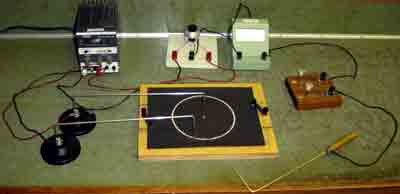Recall from the first lecture that in order to map the electric field, we placed a positive charge, +q, in this field and measured the force on the charge. We moved the charge around, and drew some arrows showing the direction of the force. We then said that the electric field strength at a particular point in space was equal to the electrostatic force divided by our test charge +q. (E = F/q or F = qE).
Unfortunately, this turns out to be hard to do in real life.
What can we do if we want to find out what the electric field looks like for a particular charge configuration?
There is another way to map the electric field. We can map the equipotential lines. Equipotential means "same potential". An equipotential line is a line for which the potential is constant for every point on the line.
What does an equipotential line have to do with the electric field?
Answer:Electric field lines are perpendicular to the equipotential lines at all points in space.How do we measure the equipotential lines? That's easy. All we have to do is measure the voltage at all points in space. The equipotential lines are all the points which have the same voltage.As easy as this sounds, it is a little harder to do in practice. To get the charge configurations, we will use a piece of paper with silver conducting paint on it. This paper that we are using is a special kind of paper called Teledeltos paper, which will allow current to flow in the direction of the electric field when a potential is applied to it. We will construct the circuit shown, and place the 0 V and 10 V leads on the silver paint. The potentiometer (or helipot as it is called in the manual) is a variable resistor (we are allowed to change the resistance of the resistor). The potential of the middle lead of the potentiometer depends on the resistance which you have set it to. Let's call the potential of the middle lead V1. The potential at the probe is the potential of the paper at that point; let's call that V2. If V1 = V2, then no current will flow through the ammeter. If there is a potential difference, then current will flow. If we set the potentiometer voltage V1 to 2 V and we observe no current in the ammeter, then we can say that V1 = V2 = 2 V.

